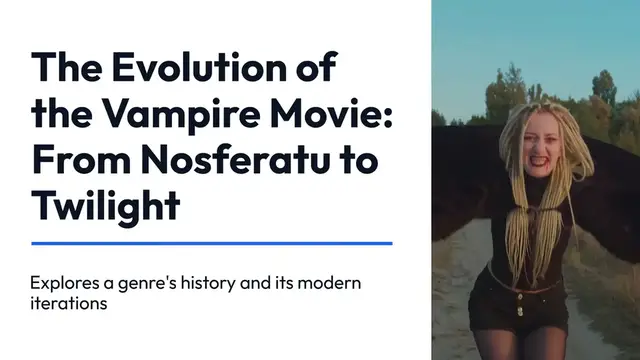
The Evolution of the Vampire Movie From Nosferatu to Twilight
Dec 26, 2024
The Evolution of the Vampire Movie: From Nosferatu to Twilight
Vampires have long been a staple of horror cinema, evolving from terrifying, monstrous creatures into complex, often romanticized figures. The journey of the vampire film has spanned decades, shifting from pure terror to themes of love, identity, and existential questions. From the eerie shadows of Nosferatu to the sparkling allure of Twilight, vampire films have undergone a dramatic transformation, mirroring changing cultural attitudes, technological advancements, and societal shifts. This article explores the evolution of the vampire movie, tracing its path from the birth of cinema to the modern, more glamorous portrayal of these iconic creatures of the night.
Nosferatu (1922): The Birth of the Vampire Film
The journey of the vampire in cinema begins with F.W. Murnau’s 1922 silent film Nosferatu, which remains one of the most influential horror films in history. Loosely based on Bram Stoker’s Dracula, the film introduced audiences to Count Orlok, a sinister and grotesque vampire portrayed by Max Schreck. The film’s depiction of vampirism as a monstrous affliction, with Orlok’s gaunt features and disturbing behavior, set the tone for the early depiction of vampires in film: terrifying, inhuman, and linked to death and decay.
Nosferatu’s influence on the horror genre is immeasurable. The film used atmospheric lighting, stark shadows, and innovative camera techniques to craft a sense of dread that became a hallmark of the genre. Orlok's unsettling presence, combined with the eerie, expressionistic set design, made the vampire a nightmarish figure that represented fear of the unknown and the supernatural. It was a stark contrast to the more romanticized vampire depictions that would emerge decades later.
Dracula (1931): The Rise of the Romantic Vampire
After Nosferatu, the vampire movie landscape began to shift with Universal Studios’ 1931 film Dracula, directed by Tod Browning and starring Bela Lugosi in the iconic role of Count Dracula. While Nosferatu had established the vampire as a grotesque, villainous creature, Lugosi’s portrayal of Dracula brought a new layer to the character: charm, elegance, and an almost hypnotic allure. The film played heavily on themes of seduction and control, as Dracula is both terrifying and charismatic, embodying the duality of danger and fascination.
Dracula introduced the vampire as a tragic and seductive figure, rather than just a monster. Lugosi’s suave and cultured portrayal of the vampire set the stage for future films in which vampires were no longer purely evil creatures but were also complex, even sympathetic figures. This romanticized version of the vampire would continue to evolve throughout the 20th century, influencing how filmmakers approached the vampire genre.
The Hammer Horror Series (1950s-1970s): Blood, Sex, and Violence
By the 1950s and 1960s, the vampire genre began to embrace more explicit themes of sex and violence. Hammer Horror, a British film studio, became synonymous with the modern vampire film, particularly with the release of The Horror of Dracula (1958), starring Christopher Lee as the infamous Count. Lee’s portrayal of Dracula was both charismatic and menacing, further developing the idea of the vampire as a figure of sexual allure and predation.
These films, characterized by their Gothic settings, rich color palettes, and more explicit violence, pushed the boundaries of what was considered acceptable in horror cinema. The vampire was no longer just a creature of the night but a figure who could both seduce and kill, embodying the darker aspects of human desire and fear. The Hammer series helped cement the vampire’s place as a symbol of both forbidden love and monstrous destruction.
Interview with the Vampire (1994): The Vampire as Tragic Hero
By the 1990s, the portrayal of vampires had evolved even further. In Interview with the Vampire (1994), based on the novel by Anne Rice, the vampire was presented not as a mindless predator but as a tragic, complex being grappling with immortality, morality, and loneliness. The film, starring Tom Cruise and Brad Pitt, depicted vampires as cursed immortals, forced to confront their existence in an increasingly hostile and changing world.
Show More Show Less #Sports
